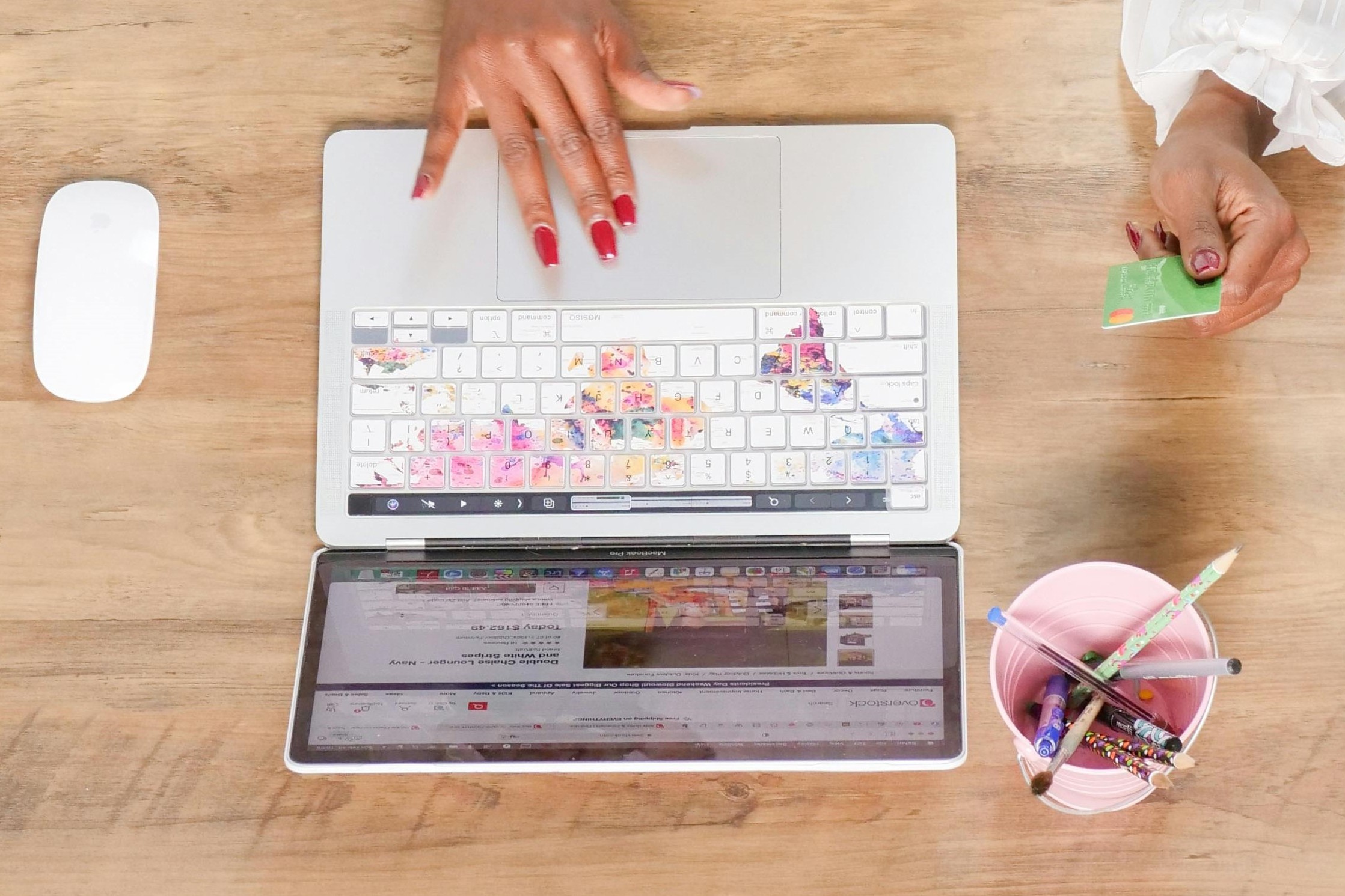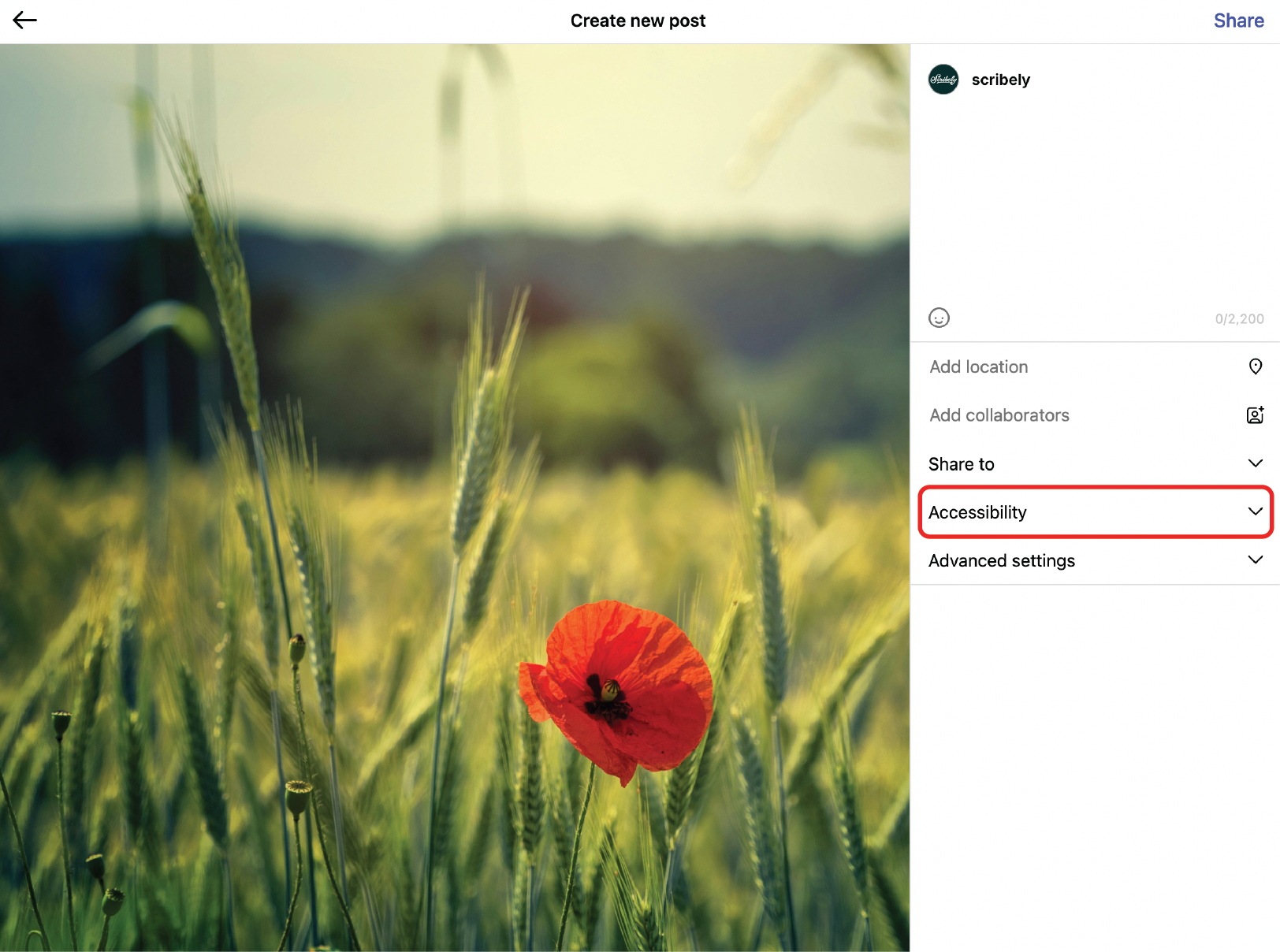Introduction
Gain invaluable insights into the state of accessibility for online shoppers and discover untapped potential for your business. Scribely collected data on the top 45 e-commerce businesses in the United States, from fashion and gaming to beauty and electronics. We reviewed the accessibility of images and videos at several points along the customer journey, including social media, landing pages, and product pages.
Overview
It is estimated that by 2027, 23% of retail purchases will take place online, and the e-commerce market is expected to total over $7.9 trillion (source: Forbes). Included in that market are Disabled people who shop online weekly more than twice as often as the population as a whole (source: Fable) and, with their network of family and friends, represent $13 trillion in annual disposable income (source: Return on Disability).
But what happens when the e-commerce experience isn’t accessible and isn’t designed to meet their needs? Can they get the information they need to make key shopping decisions and complete their customer journeys to the point of purchase?
To find the answers to these questions, Scribely completed the first-ever E-Commerce Content Accessibility Report for Global Accessibility Awareness Day (GAAD) 2023 to analyze the accessibility of images and videos on the top 100 e-commerce websites.
For 2024, we went a step further to focus on the quality of alternative text (alt text), captions, descriptive transcripts, and audio descriptions on product pages, landing pages, and social media. Scribely collected data on the top 45 e-commerce businesses in the United States across several categories, from fashion and gaming to beauty and electronics.
Ultimately, we found that 98% of product pages were either completely lacking alt text or had such poor quality alt text that a Disabled customer using assistive technology would experience significant barriers in completing their shopping journey. The results were similar for video, as well as across landing pages and social media. For the top 45 e-commerce brands, media accessibility requirements in general are severely lacking in quality across the board.
The lack of accessible content is bad for people and bad for business. Disabled customers are encountering multiple barriers to purchase and currently are not getting their shopping needs met. As a result, companies are losing out on conversion rates, customer lifetime value, and customer retention.

Key Findings
Product Pages
- For images, only 1 out of 45 of the top US online retailers’ sites had meaningful and descriptive alt text. 98% of e-commerce websites left Disabled users without an explanation of the products they are seeking to buy.
- For videos, 44% had captions, 9% had transcripts, and 2% had audio descriptions. Although this is better than images, videos are still lacking key accessibility design components that help Disabled users shop.
- Overall, every e-commerce site was missing an accessibility requirement for either images or videos.
Social Media
- Of the e-commerce brands analyzed, 0 out of 45 had meaningful and descriptive alt text images on Instagram. Without alt text, Disabled customers can’t become aware of brands while using social media, which impacts a brands’ ability to generate new online sales with this customer base.
- Videos had some caption coverage at 78%, but 0% had transcripts, and 0% had audio descriptions. In terms of consistency for captions on Instagram over the one-month period we analyzed, 13% had captions for all videos, 64% had some videos missing captions, and 22% did not have any captions.
Landing Pages
- For landing page images, Scribely found 22 brands had missing alt text, 19 were incomplete, 3 were inaccurate, and 1 had good quality alt text. Without improving these numbers, Disabled visitors aren’t able to convert to customers from their landing page experience.
- For videos, 28 brands had videos with captions, 18 were poor quality, generated by AI with numerous errors, and not edited.
Results
Product Pages
Images
Only 1 out of 45 brands (2%) had meaningful and descriptive alt text for images on product pages.
The most common error for product page images was auto-generated and formulaic alt text (91% of pages). In most cases, e-commerce brands copied the Product Title and programmatically added a generic value like “Image 1, Image 2, Image 3,” perhaps to distinguish the product images or avoid being flagged for repetitive alt text.
Some of the less common alt text quality errors for product images were: missing or empty alt text (11%), inaccurate information found in at least 1 alt text description (11%), using image file names instead of descriptions (4%), and keyword-stuffed alt text descriptions (2%)
Image Description: Vertical bar chart titled, "Alt Text Quality Errors." The y-axis has a scale of 0 to 50 Top US Retailers in intervals of 5. The x-axis is labeled "Quality Errors Found." The data points for all 5 categories of quality errors are as follows, from greatest to least: 1. Formulaic, 41. Repeats adjacent text, 38. Missing, 5. Inaccurate, 5. File Name, 2.
Videos
All 45 brands utilized product videos on their websites, but only 44% had captions, 9% had transcripts, and 2% had audio descriptions. Of the 21 product pages that included video captions, 5 or 23% had captions that were poor quality and likely AI-generated. For the remaining product pages, 11 or 24% were silent videos that did not require captions, and 13 or 29% had audio without captions.
Social Media
Images
Social media profiles on platforms like Instagram are opportunities for businesses to make a first impression or build loyalty with existing customers. This is where many people begin their customer journeys and decide whether they are interested in checking out more details on a brand’s website and product pages.
To obtain a representative sample of images, we reviewed Instagram posts from a one-month period (April to May 2024) for all 45 companies. Unfortunately, we could not find a single account that had meaningful and descriptive alt text for image posts. 47% of accounts had missing or empty alt text, and 53% relied on Instagram’s AI-generated alt text.
The screenshot below includes a real example of AI-generated descriptions on Instagram for image posts from Gap. The descriptions are formulaic: "Photo by <account> on <date>. May be an image of <insert AI visual description>." In this case, "Photo by Gap on May 5, 2024. May be an image of 2 people, braids and jacket." And, "Photo by Gap on May 5, 2024. May be an image of 2 people and jacket." The first part of the formulaic alt text is non-descriptive and arguably doesn't belong in alt text. The second part is a basic, generic description that lists out elements the AI can "see" without connecting them together in a meaningful way.

Videos
As with product videos, brands’ social media videos fared slightly better than their images. 78% of accounts had captions for more than 1 video, but only 13% of accounts had captions for every video. 64% had captions for some videos but not all, and 22% did not have captions for any of their videos. Many of the accounts with mixed caption results had inconsistent video captioning styles, which may indicate a lack of standardized captioning guidelines and vendor requirements.
We could not find any descriptive transcripts or audio descriptions for video posts. It’s important to note the Instagram platform does not support these accessibility requirements for individual posts. For brands to offer descriptive transcripts or audio descriptions, they would need to provide temporary links on their profile page or via a third-party link page.
Landing Pages
Images
We found a surprising number of image errors on featured pages. We specifically looked at non-decorative images that should have meaningful and descriptive alt text and found the following: 22 landing pages were missing alt text altogether, 19 had incomplete descriptions, 3 had inaccurate descriptions, and only 1 had meaningful and descriptive alt text for images.
Videos
All 45 brands utilized landing page videos, and we found that 28 (62%) e-commerce sites provided videos with captions. However, upon further review, 17 (60%) of those videos had poor quality, AI-generated captions with several errors, 1 was clearly human generated but difficult to read, and only 10 (36%) had good quality captions without errors.
Why this is bad news for the e-commerce customer journey
Say you’re a major online retailer and you have a customer who wants to purchase a KitchenAid mixer. Let’s name her Beth. Beth is a blind person who prefers to navigate websites and make her purchases using a screen reader and mobile phone.
Her mobile screen reader allows her to swipe through all of the text, buttons, links, and images on web pages to listen to product information read out loud in audio form.
Never heard a screen reader before? Check out Ross Minor's video, How Blind People Use Computers.
Beth is an avid baker who takes pride in her kitchen. She wants to make sure she selects the KitchenAid mixer that best meets all her desires and requirements. She needs to know all the specs, including model, color, dimensions, and attachments in order to decide which mixer she’d like to buy.
With 98% of e-commerce product pages having low quality or inaccurate alt text, it is more than likely that when Beth tries to use her screen reader on her favorite brand’s product page to decide which mixer to buy, all she hears is, “Image 1 - KitchenAid Artisan Stand Mixer, Image 2 - KitchenAid Artisan Stand Mixer, Image 3 - KitchenAid Artisan Stand Mixer…” Or, worse, there isn’t any alt text at all, as is the case on the Amazon product page below:
Without visually descriptive alt text, Beth can’t move forward in her purchasing journey because she is missing key information needed to make a decision. Though the images contain product features, specifications, and even warning labels, Beth can’t access that information without alt text and thus can’t tell what she’s buying and why. Ideally, there would be accompanying alt text that provides a 360-degree description of all sides of the product, conveying any relevant text labels and other information that’s part of the image. Just as each image provides new information that builds toward a complete understanding of the product, the accompanying alt text should do the same. If it was worth including or featuring in the image, then it should be described in the alt text.
Accessibility breakdowns like this can happen across platforms at any stage of the e-commerce journey. It’s important for businesses to continually reassess their entire journey’s accessibility because breakdowns force customers to abandon their carts due to being unable to gain the information necessary to make an informed decision. And once this happens, it’s unlikely they’ll be back. They experienced barriers in the shopping experience and discovered that your brand is not meeting their needs.
Recommendations for alt text development
Our findings demonstrate that if you are an e-commerce company, chances are you are not implementing high quality alt text (or any alt text) as a part of designing your customer journey. (If you’re not sure, you can check alt text on your product pages by copying and pasting any URL into Scribely’s Alt Text Checker.) And in a world where 62% of Americans use voice-assistant-enabled devices like iPhones or Alexas (source: NPR), it’s critical to make sure all customers can access products in alternative audio formats.
Here are a few recommendations on how to add alt text into the design of your customer experience:
- Include a content accessibility expert as a key member of your team. If you have a UX designer, engineer, marketer, or copywriter, there should also be a role dedicated to developing accessible media so that customers using screen readers can fully access your products and confidently complete their purchases.
- Develop UX design and marketing principles and guidelines that include alt text. Alt text should be considered a crucial element that allows customers to focus on the details of your product and make a decision about purchasing. Prioritizing alt text as early as possible in the creative process will improve your online shopping experience.
- Allow customers to provide feedback on product page image and video quality to determine if your intended message is received. This ensures that customers who use assistive technologies like screen readers and descriptive transcripts can consider their choices, make a purchase, and return to your brand in the future.
- Assume accessible image and video creation is an iterative process. No matter where you are in your accessibility journey, there is always a way forward. This might mean starting with products released after a specific date or securing budget and resources to chip away at existing best selling products over time.
Final Thoughts
Across the board, we found that internal and external sites are built with missing, inaccurate, and incomplete images and videos, which leads to untenable shopping experiences.
Accessibility barriers are a lose-lose situation. Disabled shoppers lose shopping options, while companies lose not only sales and revenue, but also customers as they aren’t likely to return to their sites. Accessibility is an opportunity to grow and reach more customers, to demonstrate action and progress to loyal online shoppers.
It can seem daunting to take on another step in the design and publishing process. There’s a lot of uncertainty about which tools to use for accessibility, when to start the process, and how to evaluate the quality of accessibility requirements. We’re here to help.
If you’d like support in developing your media accessibility solutions, please reach out to us at Scribely. As accessibility experts, we’re on a mission to transform the internet into a win-win: No more accessibility barriers AND no more missed sales opportunities.

Ready to get started?
Reach out to Scribely to find out how you can deliver accessible e-commerce journeys.
Contact ScribelyCite this Post
If you found this guide helpful, feel free to share it with your team or link back to this page to help others understand the importance of website accessibility.







.jpg)





.jpg)



























_edited_6x4-p-1080.jpeg)


